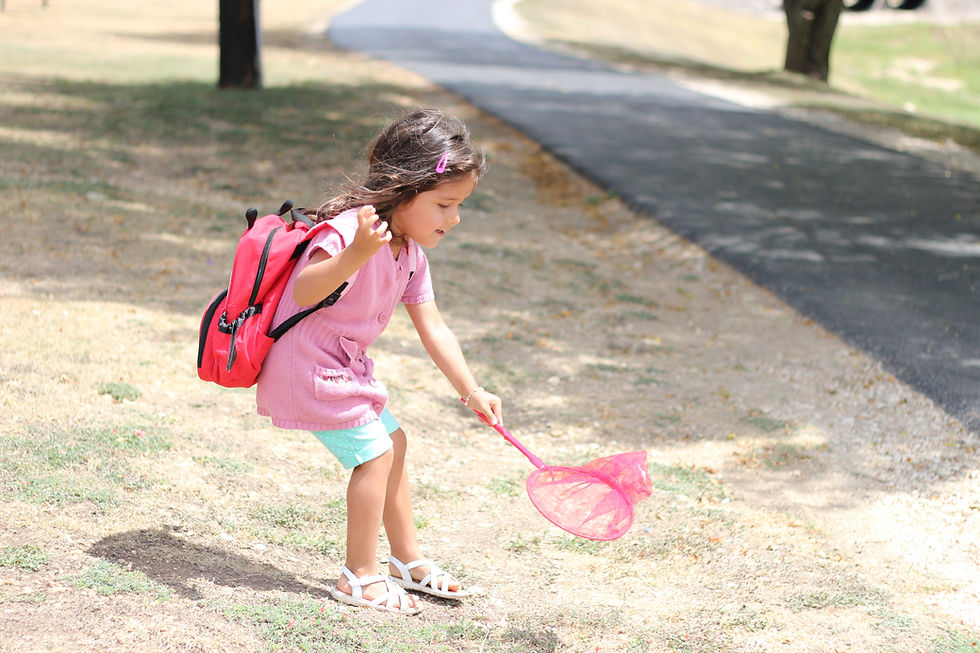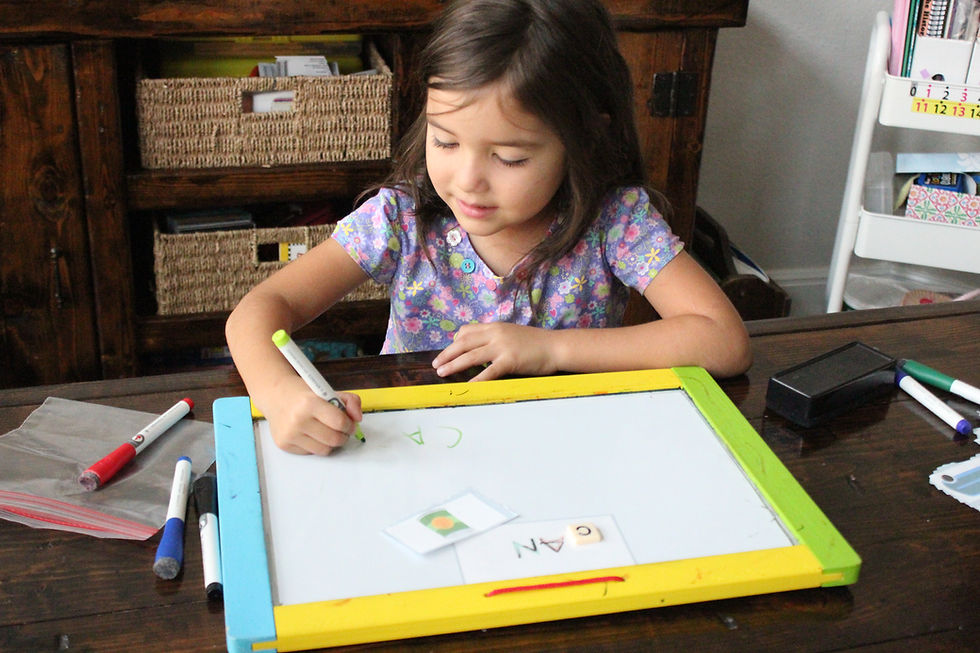Teaching Your Child to Read: What You Need to Know
- Veronica

- Mar 23, 2021
- 5 min read
Updated: Oct 30, 2025
I used to think that every child had to read by 5 or 6 years old. I used to fear being “behind,” and I often pushed through curriculum to stay on track.
Despite my pushing and stress, however, two of my children still had a harder time with reading due to eye convergence insufficiency and dyslexia.
The other decided she would read by 3 years old and now reads books well above her “grade level.”
Had I based my parenting or teaching on either one of them at that time, I may have felt like a failure, or I may have been filled with pride. Neither would have been beneficial to our children or homeschool.
Through the years, I have come to learn how very different each child is, and how much more important it is for me as a parent to encourage and provide the specific support for growth instead of trying to keep up with an arbitrary system of levels. Children will advance and learn when they are nurtured and given the tools for learning.
Teaching the Whole Child
I've learned that it is so very importantfor little ones to play and spend time outdoors and to explore and imagine, rather than to focus solely on academics. There is so much more to a child’s cognitive, emotional, and social development than learning their ABC’s by 3.

I have also learned that education is not limited to age or manmade timeframes. It is a lifelong endeavor.
If you have a little one, who is taking a bit more time to learn to read, then I want to encourage you to enjoy those precious years without worry and fear. Allow plenty of time for imaginative play and outdoor adventures. Enjoy beautiful art, bake cookies, solve puzzles, and color and paint and build.
Enjoying the Art of Language
Read aloud to your child, and discuss beautiful books together. Read poetry, sing nursery rhymes and the alphabet song, and engage in finger plays and pretend play. Talk about the clouds and the rain and the little caterpillars on the leaves. Have meaningful conversations about all of the “why’s” and the “how’s.” Share Bible stories and pray.
The skill of reading is built upon a strong understanding of language. Embrace those opportunities to engage and enjoy language together.

Then, when your child is ready and begins to show an interest in reading, introduce the letters that make up the written word.
Teaching the Alphabetic Principle
Sing the alphabet song once again, this time pointing to each letter. Put together alphabet puzzles, and practice drawing letters on the sidewalk or chalkboard with chalk. Use a salt tray for a bit of extra fun, or build letters with clay.

Watch learning videos together, such as those by LeapFrog's The Letter Factory, and go on scavenger hunts as you search for letters in books or in a pile of magnetic letters. Play with the letters, call out their names, and introduce their sounds. Watch the short video below for specific tips on teaching letter sounds.
Keep track of your child's progress in a notebook or in your Preschool/Kinder Bucket Planner. Circle the letters as they learn to identify them, and then take note when they learn their most common sounds. (Watch my video series Homeschool Preschool and Kindergarten--How to Get Started for more information on how to do this.)
Beginning reading requires a strong understanding in each of the following skills:
Identifying capital letters.
Identifying lowercase letters.
Matching capital and lowercase letters.
Learning the most common phonograms or sounds for each letter.
Make sure to provide the necessary support for future success.
Teaching Phonics and Decoding
After your child learns the basic graphemes (letters) and phonemes (sounds), then the next big step is to learn how to blend those sounds together to read words. Begin with short consonant-vowel-consonant words, such as CAT, MAT, BAT. Teach different word families, such as those that rhyme with JET, DOT, HUT, etc.

As your child gets better at this, introduce the different letter combinations, such as consonant blends (bl, fl, tr), digraphs (ch, th, sh), vowel teams (-ai-, -ay, ea), diphthongs (oi, ou, -oy), etc. to read and write new words.
Then write words on cards and tape them throughout the house: door, window, toys, books, etc. Read nursery rhymes, and point out each word, pointing out the letter combinations and phonics rules. Try copying the words on index cards and then practice putting them in order. Enjoy reading beginning readers together to apply learning, and as before, keep reading aloud and enjoying language together each day.
Your child’s brain will begin making connections between it all when he or she is developmentally ready. And when they do, they’ll be able to begin decoding and recognizing larger words in print. It’s amazing how much more easily reading happens when you wait for your child rather than imposing arbitrary standards established by a system that often leaves many children behind.
In homeschooling, there is no “behind.” There is only moving forward.
Supporting Your Child
If your younger child is not making progress early on, I want to encourage you to take a step back, put away the letters, and try again a bit later. If your child is older and still struggling with letter recognition, consider checking for eye issues. Does your child need glasses? Could your child have eye convergence insufficiency or dyslexia?
If you rule out physical challenges, consider trying a different approach. Look for a curriculum that uses a multi-sensory approach, provides adequate repetition and review, and teaches phonics in an effective and systematic way.
Nurturing Connections in Reading is the curriculum I just released that targets each of these areas in an easy "open-and-go" curriculum.
Other great options are as follows:
All About Reading: Pre-reading This curriculum teaches all of the capital letters, followed by the lowercase letters. Children read a short poem for each letter, and complete a simple hands-on activity for the letter. They also engage in matching rhyming words and other card activities.
All About Reading: Level 1 This level progresses rather quickly and requires a good understanding in the capital and lowercase letters and their most common sounds. Every other lesson introduces new phonemes or letter combinations, along with an activity and fluency pages for practice. In between, children practice reading from the included reader.
Rod and Staff’s Bible Nurture and Readers Series for Grade 1 The 3rd edition picks up quickly and requires an understanding of the letters and sounds, but the newest edition starts by teaching each of the letters and provides plenty of practice if needed. Rod and Staff combines phonics plus sight reading and advances rather quickly, but I have found it helpful for the child that gets "stuck" with blending and needs a little boost.
The Reading Lesson This affordable option is a no-fluff and easy approach to teaching reading. It quickly introduces the letters, their sounds, and decoding activities to get children reading quickly. It begins with lowercase letters, then slowly adds on capital letters as well. This is a good option for the child who picks up reading rather quickly.
Other popular choices include Teach Your Child to Read in 100 Easy Lessons and Explode the Code. Click on the provided affiliate links above to view samples and reviews.
Moving Forward
All children can thrive when they are loved and encouraged above all—not for what they can do but for all that God has made them to be. Let us always remember to put our children before the content we teach and to celebrate the victories along the way.
The truth is, we are all learning as we move forward.
Each and every day, we pick up where we left off, be it at 5, 9, 12, or 43. We get up, and we grow and learn a little more, one day at a time, one month at a time, one year at a time . . .
Enjoy the sweet journey, Friend.
Did you enjoy this post? Could you use more encouragement and support? Subscribe for free printables and resources.





.jpg)














Comments